In the raucous new comedy film "The Animal", released on the 2nd November, Rob Schneider plays a 6-billion dollar man with a difference: his new parts have come from an animal.
All is well in the beginning as he can swim like a dolphin, run like a horse and smell like a dog. But soon, he begins to exhibit their particular, less-desirable traits. He ‘marks his territory’ like a feline, catches Frisbees like a canine, and licks himself like, well most animals.
This got us thinking. These aren’t the most attractive of features in a man, but surely he could have done worse? Just which animals would he be relieved not to have been overcome by? What are the most unusual, bizarre and downright eccentric animals to be found?
We reveal the animal bits no one would want.
The Star-Nosed Mole:
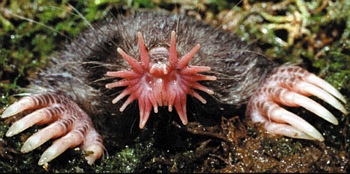
Picture courtesy of
http://exploration.vanderbilt.edu/news/news_mammals.htm
Yes, it is a real picture. Yes, it’s a real animal.
No, its head hasn’t just been blown off by a semi-automatic rifle, that’s its nose. Star-nosed mole, you see.
It has developed this peculiar shaped thing, not surprisingly, to help it find food. Well it was never going to be a fashion statement.
Its snout is surrounded by lots of ‘tentacles’. These tentacles are constantly moving when the mole is searching for food, but curl up out of the way when the mole is eating. Its favourite snacks are big juicy water worms, earthworms, and insects.
A resident of North America, the star-nosed mole likes nice wet areas of land to call home, such as swamps and wet woodland areas, though it can sometimes can be found living in drier areas such as garden lawns. Unusually for a mole it doesn’t spend that much time underground, preferring to spend much of its time above ground or in the water.
It’s a medium-sized creature, about 8 inches long, and weighs between 30 and 75g. It also has a long tail, which it uses as a rudder when swimming. Before the winter, this tail fattens considerably to act as a store of fat to see it through the harsher months. The star-nosed mole doesn’t hibernate like most animals, instead it continues to search for food, eating fish in the cold, icy water.
The Shingleback Skink:
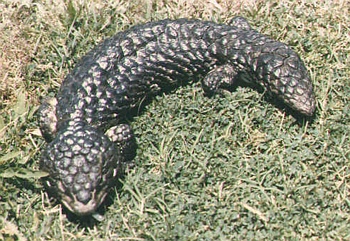
Picture courtesy of
http://www.honoluluzoo.org/shingleback_skink.htm
Two heads? Well not really, it doesn’t actually have two heads, this is just a cunning ploy to confuse would be predators into attacking the wrong end of it. The second head, its tail, is detachable and can be re-grown. Nifty, eh?
Shinglebacks, also known as stumpy-tail, bobtail, or pine cone lizards, live in dry areas of Australia, and have a varied diet any small child would be proud of. It will eat almost anything: slugs, snails, ants, fruit and flowers. Hang on a second, what small child eats fruit? When it can’t find enough food, it relies on the fat it has stored in its tail.
Like most lizards, it uses its bright blue tongue to find food via smell. It’s a very secretive animal and seldom strays from its lair. When it does it is in grave danger of being eaten, and hence has developed this two-headed, severable tail.
A by product of this, is that when complete, or even partial, break of the tail occurs, restoration may result in the formation of two, three, sometimes four ‘buds’, leading the development of many tails, and therefore many ‘heads’.
The Jerboa:
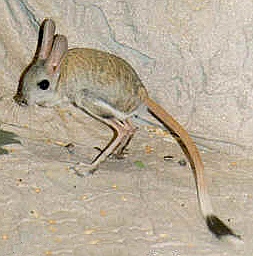
Picture courtesy of
http://users.bart.nl/~fredveen/jerboa.htm
Though it looks like a mini-kangaroo, the Jerboa is actually a small, long-tailed rodent. It is peculiar in that it is usually only 2 to 6 inches long, yet can jump up to 10 feet in one go. The equivalent of a man being able to leap tall buildings in a single bound. Is it a bird? Is it a plane? No, it’s a small rodent. Just doesn’t have quite the same ring to it.
Jerboas are found in Africa and Asia, and are an elusive, nocturnal animal, burrowing underground and resting to escape the daytime heat. Some species even go into a deep hibernation-like sleep during the hottest months.
As you can see from the picture, they have very long hind legs, small front legs, and a long tail. The hind legs are at least 4 times the length of the front legs, and are used for, yep you guessed it, jumping. The long tail acts as balance and helps it maintain a seated position, when not jumping.
Another interesting fact about the Jerboa is that it doesn’t drink. Not even a drop of whisky passes those lips, or, for that matter, water. It gets all the water it needs from the food it eats.
The Blue-Footed Booby:
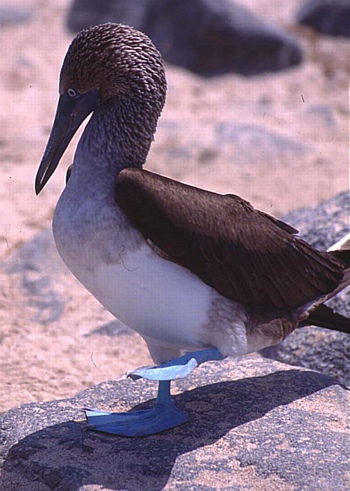
Picture courtesy of
http://www.horizon.fr/galapagos/foubleuan.html
Not very strange? Have another look at its feet. Blue, well yeah, the name gives that away. Ah, but what does it do with those feet? Those feet are the most attractive weapon a booby has. Those feet ensure the continuation of its genes.
The mating ritual of the blue-footed booby is highly organised, and the feet are the key to its success. The male raises each of his blue feet one by one in a slow stepping motion to attract the female. A comic dance worthy of any Mancunian. After doing this and enchanting the female, he points his beak toward the sky, spreads his wings and whistles. Meanwhile, the female buries her beak in her plumage, then faces it towards the sky, and groans to mimic the male. Just like Saturday night at "Roxy’s"
The name of the booby is said to originate from the Spanish word "bobo" (meaning clown or stupid fellow). The various reasons for this may be the blue feet, bizarre mating ritual, its clumsy nature, amusing poses or general tameness. No one is really sure.
It does display more strange behaviour, however. One of these is the ring of guano (excrement) that is ‘placed’ in a ring around the nesting site. Should the young chick stray outside this area, then it will no longer be treated as offspring by its parents. The reasons given for this behaviour are that it prevents parents from rearing the young of another booby. Such is the fight for attention, scientists have even witnessed cases of ‘sibling murder’ when an older brother or sister purposefully pushes the young chick outside the area in order that it is an outcast. And you think your brother's nasty.
The Fainting Goat:
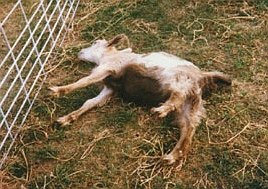
Picture courtesy of
http://www-personal.umich.edu/~jimknapp/goats.html
Oh, the poor thing. Prostrate on the floor. Due to a genetic condition called, ahhm, "myotonia congenita", it seems to faint when it is startled.
Again a bit of a misleading name for this breed of goat. It doesn’t actually faint, as technically fainting means that you lose consciousness, but merely stiffens up its muscles when surprised, but remains conscious. This muscle lock-up leads in extreme cases to them falling over and looking, well if not faint then dead. The degree of stiffness varies according to the age, purity, and amount of fright. Older goats are more adept at leaning against things and so don’t display the falling over trait as much as younger goats.
The whole palaver lasts about 15 seconds after which the goat will rise and walk off, still showing signs of stiffness.
This peculiar behaviour has actually lead to them being something of a commodity for any shepherd. If you have one of these goats in your herd of sheep and a predator, such as a wolf, attacks, the sheep will run away and the goat will wish it could. Not very nice for the goat, but let’s say ‘useful’ for the sheep.
They can be traced back to the 1880s and the hills of Tennessee. The story goes that a strange man arrived in Marshall County with this unusual goat and a ‘sacred’ cow (just what was ‘sacred’ about the cow, no one knows). The man stayed in town for a while, sold the goat to a local farmer, and left with the cow. The goat was bred with other goats and from this stock all fainting goats have derived.
Apart from the fainting tendency of the animal, they are very calm, and apparently make excellent pets (although I’ve never had one myself).
"The Animal" starring Rob Schneider opens on November 2nd 2001, and is released by Columbia TriStar Films (UK).